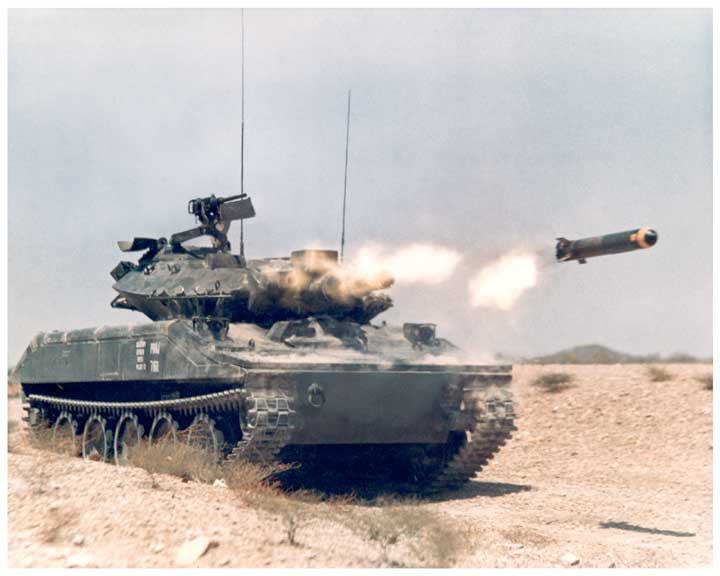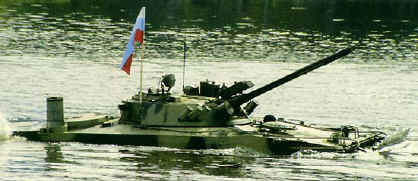Modern light tanks, defined here as weighing less than 20 tons, are valuable in many situations. They are airmobile aboard mid-sized aircraft like the C-130 and can be amphibious, which allows numerous advantages including water-landing by CL-130 Seaplanes. They can cross bridges too weak for 70-ton heavy tanks and burn one-third the fuel, which makes a big difference in long-range offensive operations. The frontal armor should withstand RPGs and 40mm cannon fire, but side armor must be limited to 12.7mm heavy machine gun fire to limit weight.
The problem light tank designers face is the turret and chassis must withstand recoil of the main gun for thousands of firings. In addition, the popular 105mm gun does not have the power to penetrate the frontal armor of a modern heavy tank. Firing a missile rather than a gun projectile eliminates these problems and doesn't require a complex stabilized gun nor a long barrel, although a stabilized target sight is required to fire on the move. Since the recoil of firing a missile is minor, the firing tube can super-elevated to fire missiles upwards at tall buildings, mountainsides, helicopters, or for very long-range engagements. The launch tube does not heat up to produce an infrared signature and does not have to be replaced every few years. In addition, the short launch tube is much lighter than a gun barrel and less restrictive in tight terrain like cities and forests.
 This was the basic idea for the M551 Sheridan light tank
(right) developed for the US Army in the 1960s. However, its electronics were
crude and the tank fired a large conventional 152mm low-velocity round with
poor accuracy. It also fired the Shillelagh missile, but that was one of
the first guided munitions with low reliability. An
excellent missile system has already been developed and proven for a modern light
tank -- the proven
laser-designated Hellfire
missile.
This was the basic idea for the M551 Sheridan light tank
(right) developed for the US Army in the 1960s. However, its electronics were
crude and the tank fired a large conventional 152mm low-velocity round with
poor accuracy. It also fired the Shillelagh missile, but that was one of
the first guided munitions with low reliability. An
excellent missile system has already been developed and proven for a modern light
tank -- the proven
laser-designated Hellfire
missile.
The $100,000 laser-guided Hellfire is great when pinpoint accuracy is required or the target is at long-range. However, if this "Helltank" is needed to provide bombardment firepower at enemy positions, it could fire $2000 dumb rockets identical in size to the Hellfire, except with more explosive power in place of the sophisticated internal guidance system. This 7-inch (178mm) rocket would have a blast-fragmentation warhead rather a shaped anti-tank warhead. These cheap rockets could also be used by attack helicopters. Hand-loading a 100lb Hellfire missile or rocket is impractical. Some type of autoloader is needed, but the Hellfire only requires two types of munitions, a guided missile or cheap rocket.
Another advantage of Helltanks is the laser-guided Hellfire is a good anti-helicopter weapon and may shoot down attack aircraft if provided with a long, clean shot. Perhaps an anti-aircraft Hellfire can be developed with a proximity fuse or an infrared seeker. While a Hellfire may not penetrate the frontal armor of modern heavy tanks, the impact of this supersonic missile will stop a tank cold after causing major damage. Hellfires have far more range than tank guns, although expensive laser-guided tank rounds for long-range indirect fires have been developed. However, tank rounds lose velocity at long range while a Hellfire missile does not. A Helltank would include the standard .50 caliber machine gun for the commander's hatch and the proven 25mm autocannon in the turret.
 Few army officers understand the value of amphibious armored vehicles like
Helltanks or the Russian BMP-3 (left) for a tactic like river cruising. An
entire battalion may enter a large river at dusk and turn
downstream. Only around three feet of the vehicle extend above the water
while the engine is literally underwater, which shields most of its noise and
infrared signature. The current in most rivers is strong enough
so that engines can be shut off and the vehicle guided with its steering
vanes. This allows a unit to ride the current downstream at night in
total silence with zero infrared signature. Unless an enemy is expecting
such a tactic, a battalion should be able to ride the river past enemy lines for almost a hundred
miles overnight without burning any fuel. This allows Helltanks and amphibious APCs to bypass defenses and appear far in an enemy's rear area, or
pass through "impassible"
mountains and forests by using rivers and lakes as roadways.
Few army officers understand the value of amphibious armored vehicles like
Helltanks or the Russian BMP-3 (left) for a tactic like river cruising. An
entire battalion may enter a large river at dusk and turn
downstream. Only around three feet of the vehicle extend above the water
while the engine is literally underwater, which shields most of its noise and
infrared signature. The current in most rivers is strong enough
so that engines can be shut off and the vehicle guided with its steering
vanes. This allows a unit to ride the current downstream at night in
total silence with zero infrared signature. Unless an enemy is expecting
such a tactic, a battalion should be able to ride the river past enemy lines for almost a hundred
miles overnight without burning any fuel. This allows Helltanks and amphibious APCs to bypass defenses and appear far in an enemy's rear area, or
pass through "impassible"
mountains and forests by using rivers and lakes as roadways.
A Helltank would be an unbeatable antitank system. It could locate just behind a berm or hillside. The gunner could take a portable laser designator to a good location a few dozen meters from his tank and dig in deeply. From there, he could use a radio to tell the tank commander the basic location where to aim the tube to fire Hellfires or rockets just over the top of the thick berm. Laser designating from a hidden location, he could devastate an attacking armored force, including supporting helicopters overhead. Attacking tanks may fire at the source of the missiles but a thick berm or hillside should protect the light tank, while the gunner continues to designate targets from his foxhole. Another option is to equip a Helltank with a periscope targeting system. Lockheed-Martin developed a Hellfiring LAV called the DAGR with an impressive telescopic sight, but the US Army showed zero interest.
Helltanks would be vulnerable to RPG fire and automatic cannon fire from the flank, but the same is true for APCs. Helltanks would prove superior to heavy tanks in many roles, but assaulting prepared enemy positions is not one of them. Heavy tanks are much better for close combat but far more expensive, burn three times more fuel, are not easily airlifted, are too dense to float for amphibious crossings, are too heavy for many bridges, and have little defense against attack helicopters. In wide open country, Helltanks will prove superior with their greater mobility and longer-range weapons system.
The US Army can quickly field an outstanding medium-weight Helltank by modifying the M3 Bradley Cavalry Vehicle. Mount the GE Blazer stabilized turret found on the LAV-AD with its GAU-12 25mm gatling gun that can be fired on the move, as described here. This is not a new idea, the US Army developed this combination but didn't field it! This would provide an excellent anti-air, anti-helicopter, anti-UAV, anti-incoming ATGM, and anti-armor capability. The slow TOWs would be replaced by Hellfires, and a system developed to mount Hellfire launchers or the Blazer's Stinger/Hydra-rocket launchers depending expected threats.
©2015 www.G2mil.com